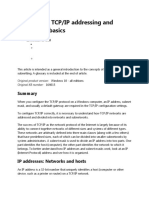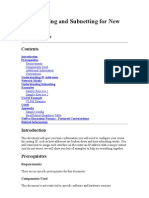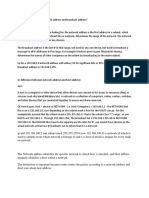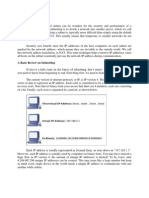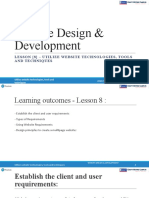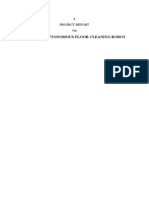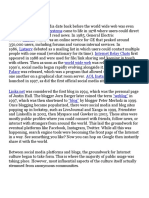Lecture Notes Introduction To IP Addressing
Uploaded by
AL Ge RonLecture Notes Introduction To IP Addressing
Uploaded by
AL Ge RonUnderstand TCP/IP addressing and subnetting basics
IP addresses: Networks and hosts
▪ An IP address is a 32-bit number. It uniquely identifies a host (computer or other device, such
as a printer or router) on a TCP/IP network.
▪ IP addresses are normally expressed in dotted-decimal format, with four numbers separated
by periods, such as 192.168.123.132. To understand how subnet masks are used to
distinguish between hosts, networks, and subnetworks, examine an IP address in binary
notation.
▪ For example, the dotted-decimal IP address 192.168.123.132 is (in binary notation) the 32-
bit number 11000000101010000111101110000100. This number may be hard to make
sense of, so divide it into four parts of eight binary digits.
▪ These 8-bit sections are known as octets. The example IP address, then, becomes
11000000.10101000.01111011.10000100. This number only makes a little more sense, so for
most uses, convert the binary address into dotted-decimal format (192.168.123.132). The
decimal numbers separated by periods are the octets converted from binary to decimal
notation.
Subnet mask
▪ The second item, which is required for TCP/IP to work, is the subnet mask. The subnet mask
is used by the TCP/IP protocol to determine whether a host is on the local subnet or on a
remote network.
▪ In TCP/IP, the parts of the IP address that are used as the network and host addresses aren't
fixed. Unless you have more information, the network and host addresses above can't be
determined. This information is supplied in another 32-bit number called a subnet mask. The
subnet mask is 255.255.255.0 in this example. It isn't obvious what this number means
unless you know 255 in binary notation equals 11111111. So, the subnet mask is
11111111.11111111.11111111.00000000.
▪ Lining up the IP address and the subnet mask together, the network, and host portions of the
address can be separated:
11000000.10101000.01111011.10000100 - IP address (192.168.123.132)
11111111.11111111.11111111.00000000 - Subnet mask (255.255.255.0)
▪ The first 24 bits (the number of ones in the subnet mask) are identified as the network
address. The last 8 bits (the number of remaining zeros in the subnet mask) are identified as
the host address. It gives you the following addresses:
11000000.10101000.01111011.00000000 - Network address (192.168.123.0)
00000000.00000000.00000000.10000100 - Host address (000.000.000.132)
▪ So now you know, for this example using a 255.255.255.0 subnet mask, that the network ID
is 192.168.123.0, and the host address is 0.0.0.132. When a packet arrives on the
192.168.123.0 subnet (from the local subnet or a remote network), and it has a destination
address of 192.168.123.132, your computer will receive it from the network and process it.
▪ Almost all decimal subnet masks convert to binary numbers that are all ones on the left and
all zeros on the right. Some other common subnet masks are:
Decimal Binary
255.255.255.192 1111111.11111111.1111111.11000000
255.255.255.224 1111111.11111111.1111111.11100000
Network classes
Internet addresses are allocated by the InterNIC, the organization that administers the Internet.
These IP addresses are divided into classes. The most common of them are classes A, B, and C.
Classes D and E exist, but aren't used by end users. Each of the address classes has a different default
subnet mask. You can identify the class of an IP address by looking at its first octet. Following are the
ranges of Class A, B, and C Internet addresses, each with an example address:
▪ Class A networks use a default subnet mask of 255.0.0.0 and have 0-127 as their first octet.
The address 10.52.36.11 is a class A address. Its first octet is 10, which is between 1 and 126,
inclusive.
▪ Class B networks use a default subnet mask of 255.255.0.0 and have 128-191 as their first
octet. The address 172.16.52.63 is a class B address. Its first octet is 172, which is between
128 and 191, inclusive.
▪ Class C networks use a default subnet mask of 255.255.255.0 and have 192-223 as their first
octet. The address 192.168.123.132 is a class C address. Its first octet is 192, which is
between 192 and 223, inclusive.
You might also like
- HCIA-Datacom V1.0 Certification H12-811-ENU DumpsNo ratings yetHCIA-Datacom V1.0 Certification H12-811-ENU Dumps10 pages
- Understanding Tcp/ip Address Computer NetworkingNo ratings yetUnderstanding Tcp/ip Address Computer Networking26 pages
- Understand TCP/IP Addressing and Subnetting Basics: 09/21/2020 12 Minutes To Read oNo ratings yetUnderstand TCP/IP Addressing and Subnetting Basics: 09/21/2020 12 Minutes To Read o7 pages
- Understanding Tcp/Ip Addressing and Subnetting BasicsNo ratings yetUnderstanding Tcp/Ip Addressing and Subnetting Basics8 pages
- IP Addressing and Subnetting For New Users - CiscoNo ratings yetIP Addressing and Subnetting For New Users - Cisco11 pages
- Understanding IP Addressing: Prepared By: Rajesh KumarNo ratings yetUnderstanding IP Addressing: Prepared By: Rajesh Kumar60 pages
- IP Addressing and Subnetting For New UsersNo ratings yetIP Addressing and Subnetting For New Users33 pages
- Configure IP Addresses and Unique Subnets-13788-3No ratings yetConfigure IP Addresses and Unique Subnets-13788-313 pages
- Communication Engineering Dept. Electronics Engineering College University of MosulNo ratings yetCommunication Engineering Dept. Electronics Engineering College University of Mosul7 pages
- How To Calculate Network Address and Broadcast AddressNo ratings yetHow To Calculate Network Address and Broadcast Address9 pages
- Protocol Internet Packetized Routed Networked: IP May Refer To Any of The FollowingNo ratings yetProtocol Internet Packetized Routed Networked: IP May Refer To Any of The Following3 pages
- IP Addressing and Subnetting For New Users: Translations100% (1)IP Addressing and Subnetting For New Users: Translations18 pages
- Network Infrastructure Windows Server: IP Address and SubnettingNo ratings yetNetwork Infrastructure Windows Server: IP Address and Subnetting42 pages
- Private Ip Addresses: Ethernet Ethernet Is The Most Used Networking Technology For Lans Today. It Defines Wiring andNo ratings yetPrivate Ip Addresses: Ethernet Ethernet Is The Most Used Networking Technology For Lans Today. It Defines Wiring and48 pages
- Address Classes: N Red NNNNNNNN NNNNNNNN NNNNNNNN NNNNNNNN NNNNNNNN NNNNNNNNNo ratings yetAddress Classes: N Red NNNNNNNN NNNNNNNN NNNNNNNN NNNNNNNN NNNNNNNN NNNNNNNN9 pages
- 1 Given:: D Annual Demand Per Unit S Ordering Cost Per Purchse Order H Holding Cost Per UnitNo ratings yet1 Given:: D Annual Demand Per Unit S Ordering Cost Per Purchse Order H Holding Cost Per Unit13 pages
- Bachelor of Science in Information Technology (BSC IT)No ratings yetBachelor of Science in Information Technology (BSC IT)4 pages
- Cambridge IGCSE: Computer Science 0478/12No ratings yetCambridge IGCSE: Computer Science 0478/1212 pages
- Sanitizer Dispenser With Temperature Monitoring Using Iot: Seminar OnNo ratings yetSanitizer Dispenser With Temperature Monitoring Using Iot: Seminar On16 pages
- Emerging Technology - Impact On Future of BusinessNo ratings yetEmerging Technology - Impact On Future of Business4 pages
- Unit 10 - WDD - Lesson 08 - Utilize Website Technologies, Tools and TechniquesNo ratings yetUnit 10 - WDD - Lesson 08 - Utilize Website Technologies, Tools and Techniques12 pages
- Full Download The Art of Reinforcement Learning Michael Hu PDF DOCX100% (2)Full Download The Art of Reinforcement Learning Michael Hu PDF DOCX51 pages
- 1.2MIS - Marketing Information System (With Diagram)No ratings yet1.2MIS - Marketing Information System (With Diagram)6 pages
- Iot Based Autonomous Floor Cleaning Robot: A Projrct Report OnNo ratings yetIot Based Autonomous Floor Cleaning Robot: A Projrct Report On47 pages
- Report of Visit To Warwick Universty UKNo ratings yetReport of Visit To Warwick Universty UK13 pages
- Gamasutra - Q&A - Translating The Humor & Tone of Yakuza Games For The WestNo ratings yetGamasutra - Q&A - Translating The Humor & Tone of Yakuza Games For The West11 pages
- Apache-CloudStack-PoCGuide-2025-ShapeBlueNo ratings yetApache-CloudStack-PoCGuide-2025-ShapeBlue106 pages




